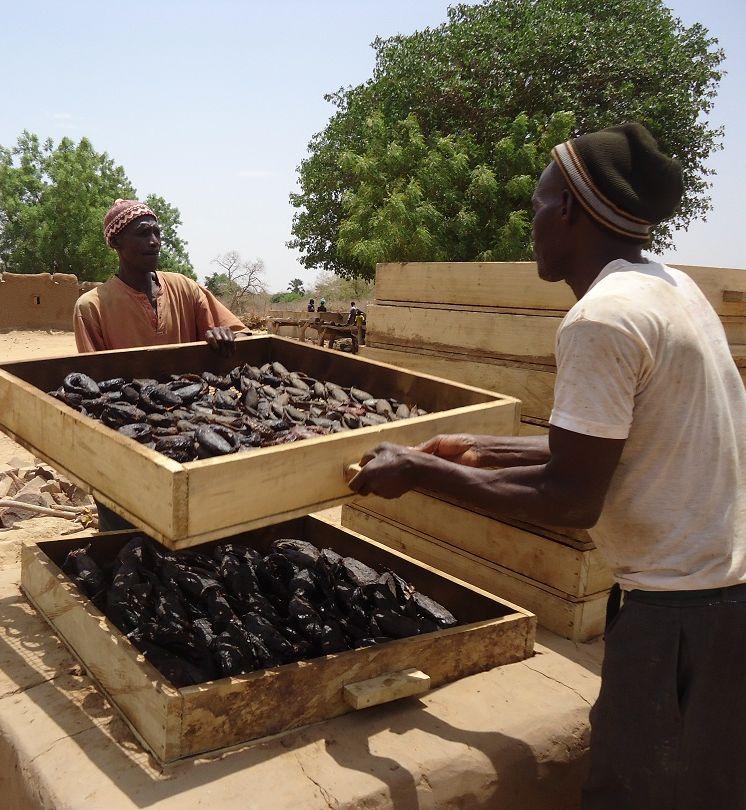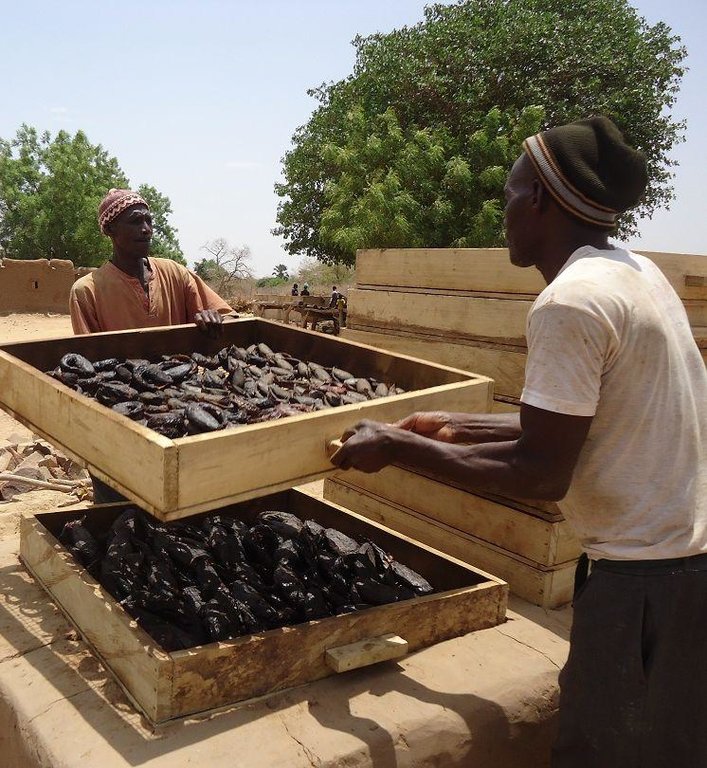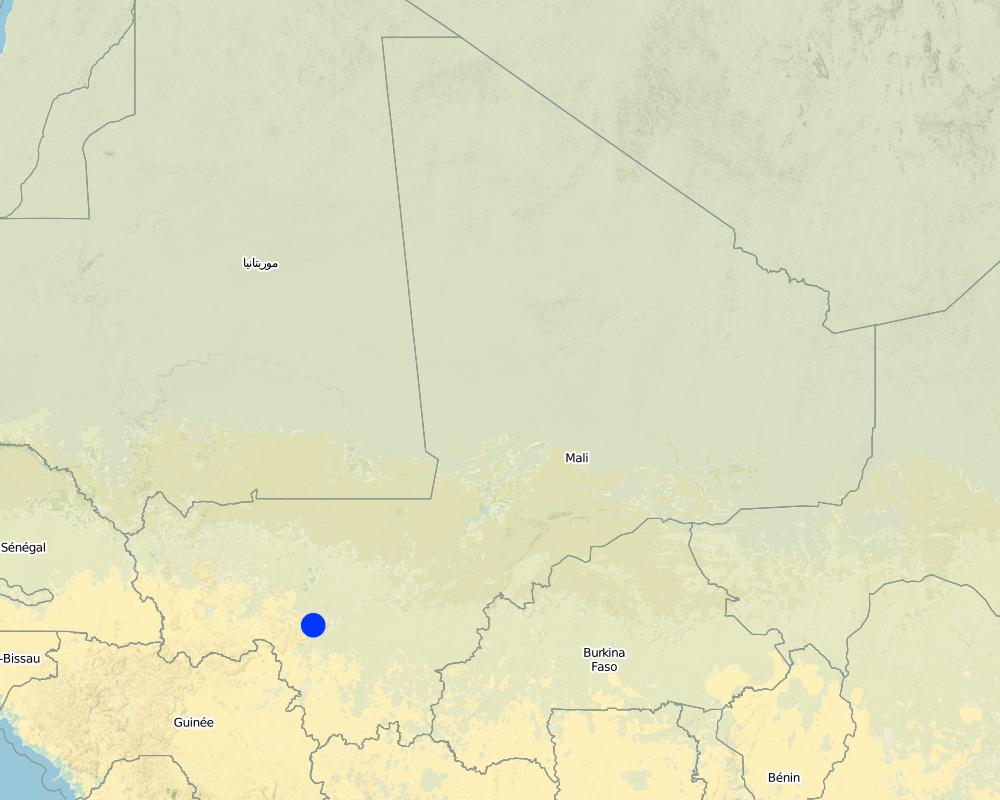Fish farming as a way of adding value to dam schemes [Mali]
- Creation:
- Update:
- Compiler: Dieter Nill
- Editor: –
- Reviewers: Fabian Ottiger, Alexandra Gavilano
Pisciculture comme moyen de valorisation des barrages (French)
technologies_1648 - Mali
View sections
Expand all Collapse all1. General information
1.2 Contact details of resource persons and institutions involved in the assessment and documentation of the Technology
SLM specialist:
Kone Mamadou Gallo
IPRO-DB Bélédougou
Mali
SLM specialist:
Schneider Ralf
IPRO-DB Bélédougou
Mali
SLM specialist:
Ouologuem Abass
IPRO-DB Bélédougou
Mali
Name of project which facilitated the documentation/ evaluation of the Technology (if relevant)
Manual of Good Practices in Small Scale Irrigation in the Sahel (GIZ )Name of the institution(s) which facilitated the documentation/ evaluation of the Technology (if relevant)
Deutsche Gesellschaft für Internationale Zusammenarbeit (GIZ) GmbH (GIZ) - Germany1.3 Conditions regarding the use of data documented through WOCAT
The compiler and key resource person(s) accept the conditions regarding the use of data documented through WOCAT:
Yes
1.4 Declaration on sustainability of the described Technology
Is the Technology described here problematic with regard to land degradation, so that it cannot be declared a sustainable land management technology?
No
2. Description of the SLM Technology
2.1 Short description of the Technology
Definition of the Technology:
Introduction of fish species suited to dam reservoirs
2.2 Detailed description of the Technology
Description:
The objective of stocking reservoirs with fish is to add value to dam schemes through artisanal fish farming and an increase in fish production.
Purpose of the Technology: This helps to improve the quality of local people’s diets and increases incomes. The technique combines fish farming and agriculture.
The low investment costs and high profitability of the activity are very attractive. The juvenile fish are available prior to each forthcoming season and local management of the scheme is easy.
Establishment / maintenance activities and inputs: The beneficiaries are guided through the process of setting up a fish farming management committee. The committee is tasked with the internal monitoring of activities to implement artisanal fish farming, while the project team takes care of external monitoring.
Implementation: organise an exchange visit between a village with experience operating this type of scheme, and the beneficiary village; train beneficiaries in artisanal fish farming; stock reservoirs with fish; care for and feed the fish; provide training on techniques used to catch and process fish (smoking and drying); construct breeding ponds; maintain a stock of fingerlings for the next season. Fish suited to both rice growing environments and fish farming should be selected. A stock of fingerlings must be maintained in breeding ponds following fish harvesting.
Roles of the actors involved: the support structure (IPRO-DB) helps with the purchase of fingerlings, builds the capacity of producers, carries out monitoring, connects technical services with traders, equips associations with fishing materials and monitoring tools, and provides support in the presentation of results at village meetings. The village committee monitors implementation (feeding, caretaking and sales) and reports on results following activities. Private sector fish farming specialists provide advisory support (fish stocking, controlling parameters, training) and monitor implementation. Merchants buy the output. The commune conducts external monitoring and provides advisory support.
2.3 Photos of the Technology
2.5 Country/ region/ locations where the Technology has been applied and which are covered by this assessment
Country:
Mali
Region/ State/ Province:
Mali
Further specification of location:
Kambila, Nonkon, Kolokani
Specify the spread of the Technology:
- applied at specific points/ concentrated on a small area
Comments:
Sonikegny village, Kambila Commune
Nonkon village, Nonkon Commune
Tiembougou village, Kolokani Commune
Korokabougou village, Kolokani Commune
5,000 people
Map
×2.6 Date of implementation
If precise year is not known, indicate approximate date:
- less than 10 years ago (recently)
2.7 Introduction of the Technology
Specify how the Technology was introduced:
- through projects/ external interventions
Comments (type of project, etc.):
Since 2009, implemented by IPRO-DB
3. Classification of the SLM Technology
3.1 Main purpose(s) of the Technology
- improve production
- create beneficial economic impact
3.2 Current land use type(s) where the Technology is applied
Land use mixed within the same land unit:
Yes
Specify mixed land use (crops/ grazing/ trees):
- Agro-pastoralism (incl. integrated crop-livestock)

Cropland
- Annual cropping
- rice
Number of growing seasons per year:
- 1
Specify:
Longest growing period in days: 120, Longest growing period from month to month: August-November

Grazing land
Comments:
Major land use problems (compiler’s opinion): low fish production
Livestock density: 1-10 LU /km2
3.4 Water supply
Water supply for the land on which the Technology is applied:
- mixed rainfed-irrigated
3.5 SLM group to which the Technology belongs
- Fish farming
3.6 SLM measures comprising the Technology

management measures
- M5: Control/ change of species composition
3.7 Main types of land degradation addressed by the Technology

biological degradation
- Bh: loss of habitats
- Bs: quality and species composition/ diversity decline
3.8 Prevention, reduction, or restoration of land degradation
Specify the goal of the Technology with regard to land degradation:
- restore/ rehabilitate severely degraded land
4. Technical specifications, implementation activities, inputs, and costs
4.1 Technical drawing of the Technology
Technical specifications (related to technical drawing):
Technical knowledge required for field staff / advisors: moderate
Technical knowledge required for land users: low
Main technical functions: spatial arrangement and diversification of land use, increase in fish production
Control / change of species composition: stocking reservoirs with fish, combines fish farming and agriculture
4.3 Establishment activities
| Activity | Timing (season) | |
|---|---|---|
| 1. | organise an exchange visit between a village with experience operating this type of scheme, and the beneficiary village | |
| 2. | train beneficiaries in artisanal fish farming; | |
| 3. | stock reservoirs with fish | |
| 4. | care for and feed the fish | |
| 5. | provide training on techniques used to catch and process fish (smoking and drying); | |
| 6. | construct breeding pods |
4.5 Maintenance/ recurrent activities
| Activity | Timing/ frequency | |
|---|---|---|
| 1. | maintain a stock of fingerlings for the next season |
5. Natural and human environment
5.1 Climate
Annual rainfall
- < 250 mm
- 251-500 mm
- 501-750 mm
- 751-1,000 mm
- 1,001-1,500 mm
- 1,501-2,000 mm
- 2,001-3,000 mm
- 3,001-4,000 mm
- > 4,000 mm
Agro-climatic zone
- semi-arid
Thermal climate class: tropics
5.2 Topography
Slopes on average:
- flat (0-2%)
- gentle (3-5%)
- moderate (6-10%)
- rolling (11-15%)
- hilly (16-30%)
- steep (31-60%)
- very steep (>60%)
Landforms:
- plateau/plains
- ridges
- mountain slopes
- hill slopes
- footslopes
- valley floors
Altitudinal zone:
- 0-100 m a.s.l.
- 101-500 m a.s.l.
- 501-1,000 m a.s.l.
- 1,001-1,500 m a.s.l.
- 1,501-2,000 m a.s.l.
- 2,001-2,500 m a.s.l.
- 2,501-3,000 m a.s.l.
- 3,001-4,000 m a.s.l.
- > 4,000 m a.s.l.
5.3 Soils
Soil depth on average:
- very shallow (0-20 cm)
- shallow (21-50 cm)
- moderately deep (51-80 cm)
- deep (81-120 cm)
- very deep (> 120 cm)
Soil texture (topsoil):
- medium (loamy, silty)
- fine/ heavy (clay)
Topsoil organic matter:
- medium (1-3%)
- low (<1%)
If available, attach full soil description or specify the available information, e.g. soil type, soil PH/ acidity, Cation Exchange Capacity, nitrogen, salinity etc.
Soil fertility: Medium
Soil drainage/infiltration: Medium and poor
Soil water storage capacity: Medium
5.4 Water availability and quality
Ground water table:
5-50 m
Availability of surface water:
medium
Water quality (untreated):
for agricultural use only (irrigation)
Comments and further specifications on water quality and quantity:
Availability of surface water: Also poor/ none
5.5 Biodiversity
Species diversity:
- medium
Habitat diversity:
- medium
Comments and further specifications on biodiversity:
Species diversity: medium, low
5.6 Characteristics of land users applying the Technology
Market orientation of production system:
- mixed (subsistence/ commercial)
Off-farm income:
- 10-50% of all income
Relative level of wealth:
- poor
- average
Level of mechanization:
- manual work
Gender:
- men
Indicate other relevant characteristics of the land users:
Population density: < 10 persons/km2
Annual population growth: 2% - 3%
10% of the land users are rich.
50% of the land users are average wealthy.
30% of the land users are poor.
10% of the land users are poor.
5.7 Average area of land used by land users applying the Technology
- < 0.5 ha
- 0.5-1 ha
- 1-2 ha
- 2-5 ha
- 5-15 ha
- 15-50 ha
- 50-100 ha
- 100-500 ha
- 500-1,000 ha
- 1,000-10,000 ha
- > 10,000 ha
Is this considered small-, medium- or large-scale (referring to local context)?
- small-scale
5.8 Land ownership, land use rights, and water use rights
Comments:
The irrigated land is allocated by the chief
5.9 Access to services and infrastructure
health:
- poor
- moderate
- good
education:
- poor
- moderate
- good
technical assistance:
- poor
- moderate
- good
employment (e.g. off-farm):
- poor
- moderate
- good
markets:
- poor
- moderate
- good
energy:
- poor
- moderate
- good
roads and transport:
- poor
- moderate
- good
drinking water and sanitation:
- poor
- moderate
- good
financial services:
- poor
- moderate
- good
6. Impacts and concluding statements
6.1 On-site impacts the Technology has shown
Socio-economic impacts
Production
product diversity
Income and costs
farm income
diversity of income sources
Other socio-economic impacts
Fish production
Socio-cultural impacts
food security/ self-sufficiency
health situation
Improved livelihoods and human well-being
Comments/ specify:
Helps to improve the quality of local people’s diets and increases incomes. The technique combines fish farming and agriculture.
Ecological impacts
Biodiversity: vegetation, animals
animal diversity
6.3 Exposure and sensitivity of the Technology to gradual climate change and climate-related extremes/ disasters (as perceived by land users)
Gradual climate change
Gradual climate change
| Season | increase or decrease | How does the Technology cope with it? | |
|---|---|---|---|
| annual temperature | increase | well |
Climate-related extremes (disasters)
Meteorological disasters
| How does the Technology cope with it? | |
|---|---|
| local rainstorm | well |
| local windstorm | well |
Climatological disasters
| How does the Technology cope with it? | |
|---|---|
| drought | not well |
Hydrological disasters
| How does the Technology cope with it? | |
|---|---|
| general (river) flood | well |
Other climate-related consequences
Other climate-related consequences
| How does the Technology cope with it? | |
|---|---|
| reduced growing period | well |
6.4 Cost-benefit analysis
How do the benefits compare with the establishment costs (from land users’ perspective)?
Short-term returns:
very positive
Long-term returns:
very positive
How do the benefits compare with the maintenance/ recurrent costs (from land users' perspective)?
Short-term returns:
very positive
Long-term returns:
very positive
6.7 Strengths/ advantages/ opportunities of the Technology
| Strengths/ advantages/ opportunities in the compiler’s or other key resource person’s view |
|---|
| The technique increases fish production, improves beneficiaries’ diets and raises incomes. |
| The low investment costs and high profitability of the activity are very attractive |
| The juvenile fish are available prior to each forthcoming season |
| Local management of the scheme is easy |
6.8 Weaknesses/ disadvantages/ risks of the Technology and ways of overcoming them
| Weaknesses/ disadvantages/ risks in the compiler’s or other key resource person’s view | How can they be overcome? |
|---|---|
| Few species of fish are suited to both rice growing environments and fish farming | |
| Water availability for at least six months from September |
7. References and links
7.1 Methods/ sources of information
- field visits, field surveys
- interviews with land users
When were the data compiled (in the field)?
01/07/2012
7.2 References to available publications
Title, author, year, ISBN:
Fish farming report and accounts
Title, author, year, ISBN:
Monitoring report for the ‘Boubacar DIALLO’ fish farm
7.3 Links to relevant online information
Title/ description:
Manual of Good Practices in Small Scale Irrigation in the Sahel. Experiences from Mali. Published by GIZ in 2014.
URL:
http://star-www.giz.de/starweb/giz/pub/servlet.starweb
Links and modules
Expand all Collapse allLinks
No links
Modules
No modules




